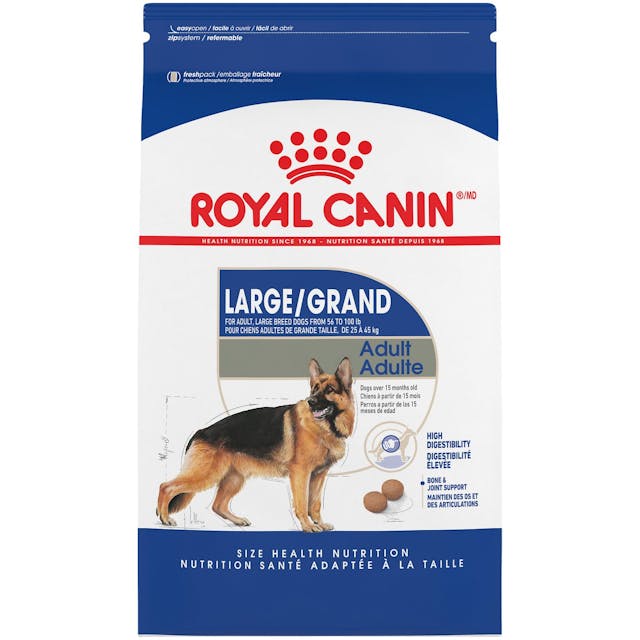
DogFoodAdvisor is reader supported See how
All reviews are 100% impartial but if you buy using links on this page, we may earn a referral fee.
Our Verdict
Royal Canin Size Health Nutrition Large Dog Food product range is made up of four recipes with ratings varying from 3.5 to 4.5 stars. The average rating of the whole range is 3.5 stars.
The table below shows each recipe in this range including our rating and the AAFCO nutrient profile: Growth (puppy), Maintenance (adult), All Life Stages, Supplemental or Unspecified.
| Product line | Rating | AAFCO |
|---|---|---|
| Royal Canin Large Adult | 3.5 | M |
| Royal Canin Large Adult 5+ | 3.5 | M |
| Royal Canin Large Aging 8+ | 3.5 | M |
| Royal Canin Large Puppy | 4.5 | G |
Recipe and Label Analysis
Royal Canin Large Adult was selected to represent the other products in the line for detailed recipe and nutrient analysis.
Royal Canin Large Adult
Estimated Dry Matter Nutrient Content
Protein
Fat
CarbsCarbohydrates
Chicken by-product meal, brewers rice, wheat, brown rice, chicken fat, corn gluten meal, natural flavors, dried plain beet pulp, fish oil, calcium carbonate, monocalcium phosphate, salt, potassium chloride, sodium silico aluminate, choline chloride, l-lysine, vitamins [dl-alpha tocopherol acetate (source of vitamin E), l-ascorbyl-2-polyphosphate (source of vitamin C), biotin, d-calcium pantothenate, vitamin A acetate, niacin supplement, pyridoxine hydrochloride (vitamin B6), thiamine mononitrate (vitamin B1), vitamin B12 supplement, riboflavin supplement, vitamin D3 supplement, folic acid], trace minerals [zinc proteinate, zinc oxide, ferrous sulfate, manganese proteinate, manganous oxide, copper sulfate, calcium iodate, sodium selenite, copper proteinate], glucosamine hydrochloride, dl-methionine, chondroitin sulfate, rosemary extract, preserved with mixed tocopherols and citric acid
Fiber (estimated dry matter content) = 3.3%
Red denotes any controversial items
| Estimated Nutrient Content | |||
|---|---|---|---|
| Method | Protein | Fat | Carbs |
| Guaranteed Analysis | 24% | 15% | NA |
| Dry Matter Basis | 27% | 17% | 49% |
| Calorie Weighted Basis | 23% | 35% | 42% |
Ingredients Analysis
The first ingredient in this dog food is chicken by-product meal, a dry rendered product of slaughterhouse waste. It’s made from what’s left of a slaughtered chicken after all the choice cuts have been removed.
In addition to organs, this item can also include feet, beaks, undeveloped eggs and almost anything other than prime skeletal muscle.
On the brighter side, by-product meals are meat concentrates and contain nearly 300% more protein than fresh chicken.
The quality of this ingredient can vary, depending on the caliber of the raw materials obtained by the manufacturer.
The second ingredient is brewers rice. Brewers rice is a cereal grain by-product consisting of the small fragments left over after milling whole rice. Aside from the caloric energy it contains, this item is of only modest nutritional value to a dog.
The third ingredient is wheat. Like corn, wheat is an inexpensive and controversial cereal grain. And aside from its energy content, this grain is of only modest nutritional value to a dog.
For this reason, we do not consider wheat a preferred component in any dog food.
The next ingredient is brown rice, a complex carbohydrate that (once cooked) can be fairly easy to digest. However, aside from its natural energy content, rice is of only modest nutritional value to a dog.
The fifth ingredient is chicken fat. This item is obtained from rendering chicken, a process similar to making soup in which the fat itself is skimmed from the surface of the liquid.
Chicken fat is high in linoleic acid, an omega-6 fatty acid essential for life. Although it doesn’t sound very appetizing, chicken fat is actually a quality ingredient.
The sixth ingredient is corn gluten meal. Gluten is the rubbery residue remaining once corn has had most of its starchy carbohydrate washed out of it.
Although corn gluten meal contains 60% protein, this ingredient would be expected to have a lower biological value than meat.
And less costly plant-based products like this can notably boost the total protein reported on the label — a factor that can’t be ignored when judging the actual meat content of this dog food.
After the natural flavors, we find beet pulp. Beet pulp is a controversial ingredient, a high fiber by-product of sugar beet processing.
Some denounce beet pulp as an inexpensive filler while others cite its outstanding intestinal health and blood sugar benefits.
We only call your attention here to the controversy and believe the inclusion of beet pulp in reasonable amounts in most dog foods is entirely acceptable.
The next ingredient is fish oil. Fish oil is naturally rich in the prized EPA and DHA type of omega-3 fatty acids. These two high quality fats boast the highest bio-availability to dogs and humans.
Depending on its level of freshness and purity, fish oil should be considered a commendable addition.
From here, the list goes on to include a number of other items.
But realistically, ingredients located this far down the list (other than nutritional supplements) are not likely to affect the overall rating of this Royal Canin product.
With three notable exceptions…
First, this food contains chelated minerals, minerals that have been chemically attached to protein. This makes them easier to absorb. Chelated minerals are usually found in better dog foods.
Next, we find no mention of probiotics, friendly bacteria applied to the surface of the kibble after processing to help with digestion.
And lastly, this recipe includes sodium selenite, a controversial form of the mineral selenium. Sodium selenite appears to be nutritionally inferior to the more natural source of selenium found in selenium yeast.
Nutrient Analysis
Based on its ingredients alone, Royal Canin Size Health Nutrition Large Dog Food looks like an average dry product.
The dashboard displays a dry matter protein reading of 27%, a fat level of 17% and estimated carbohydrates of about 49%.
As a group, the brand features an average protein content of 28% and a mean fat level of 16%. Together, these figures suggest a carbohydrate content of 48% for the overall product line.
And a fat-to-protein ratio of about 59%.
Which means this Royal Canin product line contains…
Above-average protein. Near-average fat. And near-average carbs when compared to a typical dry dog food.
When you consider the protein-boosting effect of the corn gluten meal in this recipe and the wheat gluten contained in others, this looks like the profile of a kibble containing just a moderate amount of meat.
Royal Canin Dog Food Recall History
The following automated list (if present) includes all dog food recalls related to Royal Canin through March 2025.
No recalls noted.
You can view a complete list of all dog food recalls since 2009 here.
Our Rating of Royal Canin Size Health Nutrition Large Dog Food
Royal Canin Size Health Nutrition Large is a grain-inclusive dry dog food using a moderate amount of named by-product meal as its primary source of animal protein, thus receiving 3.5 stars.
Compare Royal Canin Size Health Nutrition Large Dog Food
How does Royal Canin Size Health Nutrition Large compare with The Dog Food Advisor's most recommended brands?
A Final Word
The Dog Food Advisor does not accept money, gifts, samples or other incentives in exchange for special consideration in preparing our reviews.
However, we do receive a referral fee from online retailers (like Chewy or Amazon) and from sellers of perishable pet food when readers click over to their websites from ours. This helps cover the cost of operation of our free blog. Thanks for your support.
For more information, please visit our Disclaimer and Disclosure page.









